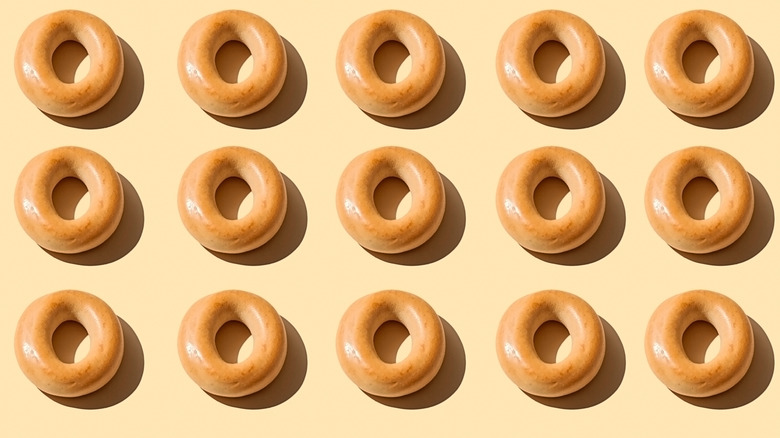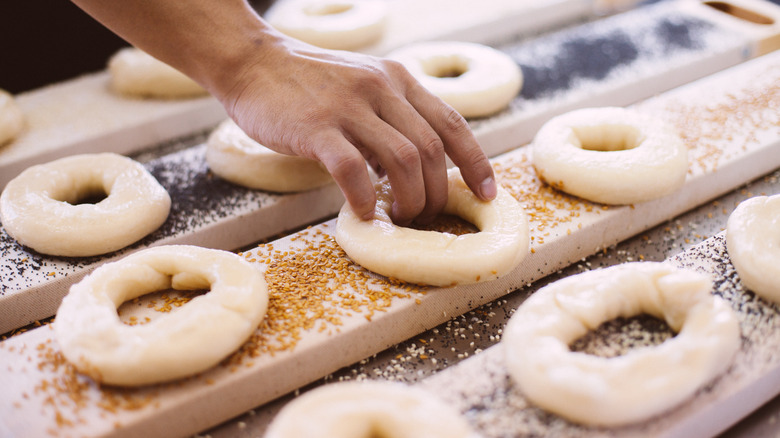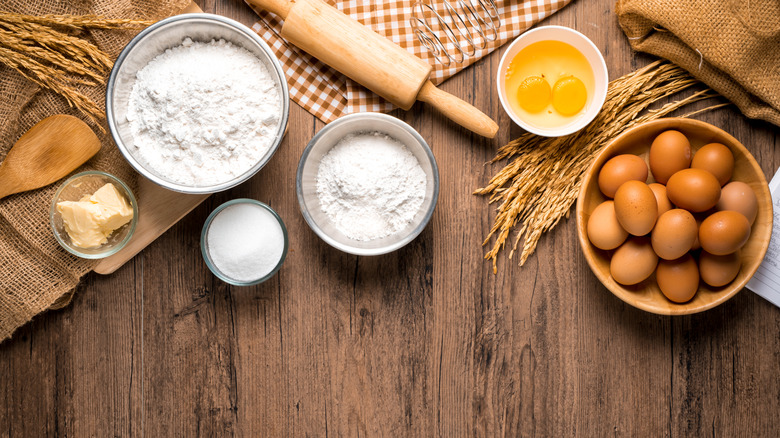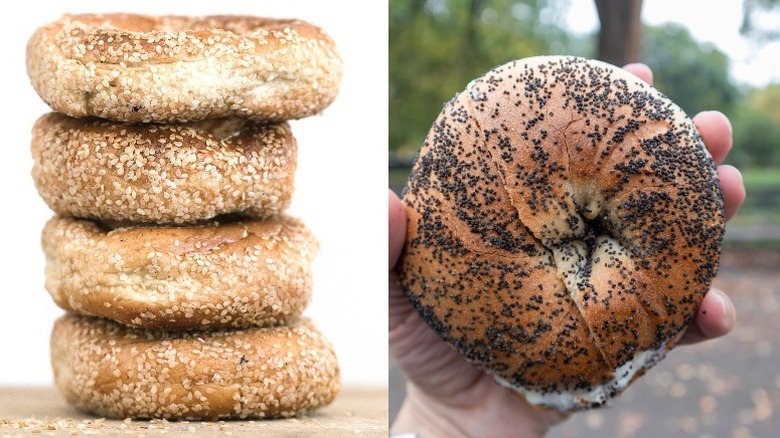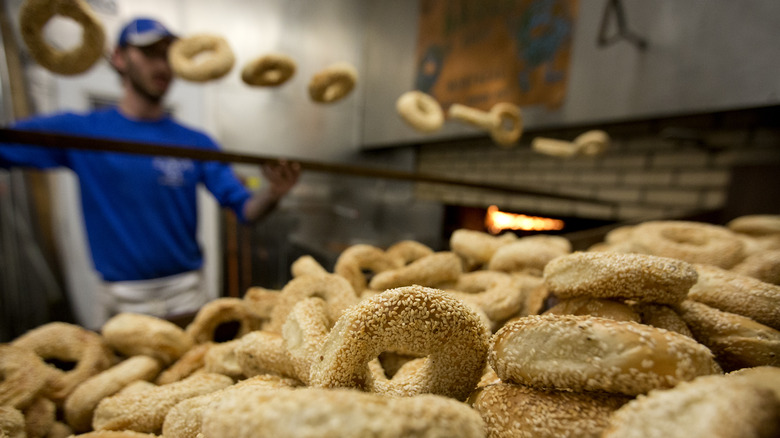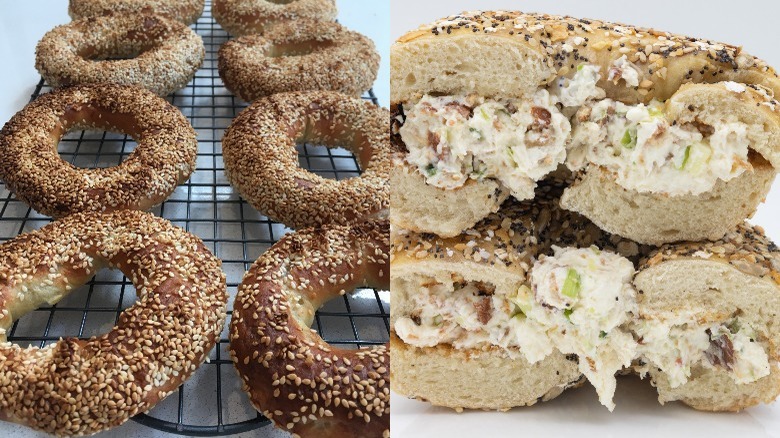Montreal Vs New York Bagels: What's The Difference?
It's common for a city to have an iconic food item, whether it's a hearty dish with dozens of ingredients (New Orleans jambalaya) or a simple snack that is sold on every street corner (Chicago hot dogs). While many cities stake their claim to a specific food, at times these specialties overlap and more than one city maintains being the source of origin or the best provider (see, pizza). When the cities are across the globe from each other it's not such a big deal, however when they happen to be geographically close, a rivalry can ensue — as has been the case with New York City and Montreal bagels.
According to Britannica, the official definition of a bagel is a yeast-leavened bread shaped like a donut. While the source indicates that they have a shiny appearance on the outside and a chewier texture on the inside, certain features make New York City bagels quite different from the version found in Montreal. The two cities are home to different histories and culinary traditions that represent diverse trends in immigration over time. All the same, it appears bagels were brought to both cities by Polish Jewish immigrants, explains MTL Blog.
The similarity ends there, though, as the site explains that regional differences in Poland dictated distinct preparations, resulting in a unique style of bagel in Montreal than what is found in NYC. And a quick visual inspection of the two styles makes it immediately obvious that we are not dealing with the same creation. Daily Hive describes Montreal bagels as thinner and denser, whereas New York bagels are larger and softer. But there's even more to the distinct differences between these two types.
Are New York and Montreal bagels made using different methods?
Part of what makes the distinction between Montreal and New York bagels so unique is that they are made using different processes. According to The Bagel Club, a significant deviation starts with the fact that Montreal bagels are hand-rolled whereas NYC bagel shops have turned to mechanization for the most part. Also, Delish explains that NYC bagels are usually left to ferment at cool temperatures in order to rise overnight, a step that is left out in the Montreal-style baked goods. Both cities boil the dough shortly before baking, though, as this helps to seal in the flavors, creating a chewy texture, according to a video by the American Chemical Society.
Another way in which the procedures diverge is that New York bagels are baked in gas-powered ovens while Montreal bagels are cooked in wood-fired ovens, giving them a characteristic crunch and flavor (via The Bagel Club). The New York Times also remarks that wood-fired ovens are highly regulated and less popular in the Big Apple. Montreal bagel shops had a scare in 2018 when the city sought to impose stricter regulations on the matter, too, however The Montreal Gazette reports that, as of present, only new businesses are banned from burning wood.
What is the difference in ingredients between the two bagels?
Aside from the different baking methods that impart their own flavors, a few key ingredients also make Montreal bagels slightly sweeter and denser than their New York counterparts. Both versions are made using flour, although NYC bagels are often made using bread flour instead of all-purpose or wheat flour, according to First We Feast.
Next, water and yeast are a must, although Spoon University remarks that New Yorkers believe that their soft tap water imparts a unique flavor and texture, due to low amounts of calcium and magnesium. Thanks to the American Chemical Society, this idea has been debunked, though, and the texture difference is more easily explained as a result of proofing and then boiling the dough.
Whereas the yeast in New York bagels is usually fed with barley malt syrup, Montrealers commonly opt for honey or sugar, hence the sweetness, as per the Daily Hive. The source also notes that NYC bagels contain salt. Additionally, Montreal bagels tend to contain eggs to make the texture chewier, explains The Bagel Club. As for the boiling process, New York bagels are dunked in plain water while Montreal bagels are poached in honey-sweetened water, adding to their flavor.
Are there differences in appearance or texture in the two bagels?
Thanks to the different baking methods and the variation in ingredients, New York and Montreal bagels could at best pass for distant cousins. They are both round in shape with a hole in the center (like most all bagels), however you might have to squint to find the hollowed-out center in a New York bagel while the Canadian version has a more sizable hole (via First we Feast).
All other aspects of a New York bagel are bigger compared to the Montreal variety: They are larger in size and, when tested in 2000, they even weighed twice as much, according to the New York Times. Conversely, Montreal bagels look more like a thin ring compared to the pillowy appearance of NYC's standard.
The different types of ovens also produce a distinct appearance. New York bagels tend to be shiny due to a combination of boiling the dough and cooking it in a gas oven, Chef Coppedge from the Culinary Institute of America tells NPR. On the other hand, NY Times Cooking describes Montreal bagels as often looking a bit charred with a browned, crispy exterior thanks to time spent in a wood-fired oven.
MTL Blog describes the texture of the two bagels as entirely opposing. Whereas Montreal bagels are dense, chewy, and with a crispier exterior, NYC bagels are more akin to a pillowy soft and slightly chewy bread. While many fans will completely reject the alternate style, between the two they are sufficiently distinct to please most people.
Famous historic shops selling Montreal and New York bagels
Although numerous places in Montreal sell bagels, there are really only two spots open since the 1950s that deserve the status of historic institutions. Fairmount and St. Viateur Bagels are family operations, each claiming to be the oldest bagel shop in Montreal, a hint that there is a rivalry even within the city limits. Both shops are located in Montreal's Mile End neighborhood, a hub for Jewish immigrants in the first half of the 20th century (via Maisonneuve). According to Fairmount Bagel, a family member even brought 18 bagels to the International Space Station in 2008!
New York City is home to countless historic bagel locations, and Untapped Cities remarks that, in 1907, the International Beigel Baker's Union was established to monopolize the production. Originally, only Jewish males who were members of the union were allowed to make bagels, but eventually regulations loosened. Of the places that have remained, Ess-A-Bagel, H&H, Russ & Daughters, Zabar's, Kossar's Bagels & Bialys, and Murray's are all known for their true NYC bagels. Many of these bagel shops are also delis, pairing other Jewish culinary traditions with the classic bagel.
Classic toppings and how to eat both bagels
Montreal's famed bagel shops primarily sell poppyseed or sesame seed bagels. Other toppings can include "all dressed" (both seeds, onion, and garlic), cinnamon raisin, blueberry, and Muesli. St. Viateur has some branches with a full café, incorporating the bagels, however the standard experience is fuss-free, and most are served with a side of cream cheese or lox (via Delish).
So, if you're used to a bagel shop with dozens of schmears and cream cheese flavors to choose from, you might be disappointed in Montreal. However, since these bagels are slightly sweet to start with, extra toppings aren't entirely necessary. As well, the giant hole in the center makes them less suited for sandwiches so you're better off enjoying a Montreal bagel as a solo snack.
Meanwhile, New York bagel shops tend to have dozens of toppings including raisin, garlic, onion, seeds, chocolate, and bacon, according to Thrillist. Since NYC bagels are thick and soft, they're more appropriate to use as a base for a sandwich, and are regularly sold in this format. Regardless of all their differences, Mad Hatters NYC notes that both cities tend to agree that cream cheese and lox on a bagel is a classic match.
